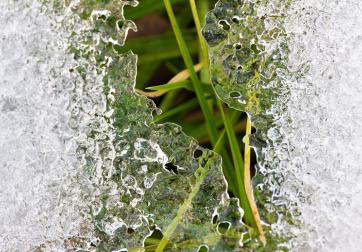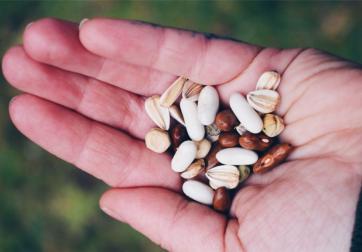Your garden does not have to become a brown boring blob in winter. There are many plants whose contrasting forms, textures and colors add winter interest. Evergreens, along with trees and shrubs with interesting bark or brightly colored stems add subtle interest as well. Shrubs covered in bright berries, ornamental grasses, and the stems and seed heads of dormant annuals and perennials serve to create sculpture and beauty in the winter landscape. Leaving the dormant foliage on plants provides winter interest, some protection from cold, and food for birds and wildlife.
There are several things you can do to help your plants survive winter. The most important thing you can do for your garden at any time of year is to actually walk around your yard often and be observant. This is the best way to catch little problems with insects and diseases before they get to be big problems.
Evergreen trees and shrubs often suffer the most during the winter months, especially when conditions are both cold and dry for extended periods. Some of your evergreens may turn a bronze color in the winter, which is natural, but brown is not a color you want to see in evergreen plants. If your evergreen turns brown, it usually means it is a goner. It probably died because of lack of water and not cold; and that is why it is so important to water evergreens during the winter months if there has not been enough rain.
Deciduous trees and shrubs tend to survive better under extreme and changing conditions because they go dormant for winter. They still may need to be pruned to remove deadwood, open the interior to promote better air circulation to minimize fungal diseases, or merely to reshape the plant. Do not ever remove more than one-third of any plant at once, because the stress of trying to recover could kill it. Always prune to retain the natural shape of the plant. Do not just lop off the top growth to create a gumdrop or lollipop shape that will send out a profusion of twigs that are prone to disease and insect damage. DO NOT commit Crepe Murder for the same reason. Not only will it severely damage your plants, it will make your plants severely ugly while they are slowly dying.
It is normal for some of your trees and shrubs to have brown leaves clinging to the branches this time of year. A number of deciduous plants including Oaks, Japanese Maples and Hydrangeas often retain their leaves throughout the winter months. Some plants even hold their leaves into early spring when they seem to drop them all at once right before time for new leaves to emerge.
You can do a lot of useful cleaning up in the garden during the winter including recycling the potting soil from outdoor container-grown annual plants that have finished their life cycle. Just make sure that the plants are free of disease before you add the potting soil to your compost pile. Break up the root balls and the roots with hand pruners or a sharp knife. After you have emptied the pots, clean them with a ten percent solution of water and bleach and store them in a shed or garage. This is especially important for clay pots that absorb moisture and may freeze and crack during the winter. Your containers will be ready for fresh potting soil and new plants next spring on the first warm day when you cannot resist all the beautiful plants the nurseries are filled with to entice gardeners who are ready for a new growing season.
It is also a good idea to empty rain gauges and ornamental features that hold water before a severe freeze. Water expands when it freezes and can crack glass, clay, concrete, ceramic and plastic. I have seen large concrete birdbaths that cracked when the water froze during a severe winter. There are small heaters made specifically for birdbaths to keep this from happening. They do double duty by making sure birds have a supply of water during the winter when it is hard for them to find it. Birds will die within a few days if they are not able to find drinking water.
Luckily, we have been getting some rain going into winter this year. I certainly hope it continues because I hate dragging hoses in winter almost as much as August. Do not forget to unhook the hoses from faucets if a freeze is expected, roll them up and store them. Water in hoses can expand when it freezes and split the hoses; and a good hose is an expensive investment. I have heard horror stories of hydrants attached to the house freezing and the pipes inside the house freezing and bursting, causing major damage and costing major money to repair; so, make sure hydrants are insulated and hoses are detached.

 Board Member Login
Board Member Login Our Store
Our Store Blog
Blog





